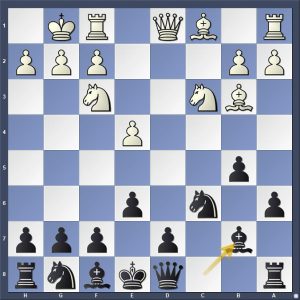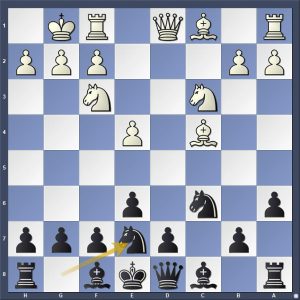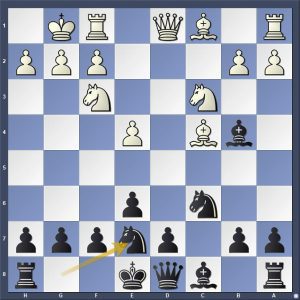After becoming familiar with potential dangers of the Morra Gambit in the last post, you will now be able to understand why I recommend the following three variations. They simply avoid the main ideas of the Morra player. We have no problem with the king’s knight, no problem with the queen, no problem with the soft spot f7 and no problem with the soft spot e6. All this together pretty much refutes the Morra.
Refutation 1) 3..dxc3 4.Nxc3 Nc6 5.Nf3 e6 6.Bc4 a6 7.0-0 b5 8.Bb3 (or 8.Bd3) LB7 =+

The charm of this line is that it is not even mentioned in Esserman’s book. Honi sois qui mal y pense!
Refutation 2) 3..dxc3 4.Nxc3 Nc6 5.Nf3 e6 6.Bc4 a6 7.0-0 Nge7 =+

Esserman pays some respect to this line by calling it “the professional’s choice.” However, he doesn’t analyze the critical position thoroughly enough. Before blaming him too harshly for this, one shouldn’t forget that the power of the engines has tremendously increased since his book was published in 2012.
Refutation 3) 3..dxc3 4.Nxc3 Nc6 5.Nf3 e6 6.Bc4 Bb4 =+

This was my improvisation when I met the Morra unprepared in 1987. I consider this the most solid line of all against the Morra.
After discussing the pros and cons of both declining and accepting the Morra, I am ready to present some final conclusions:
- There is no right or wrong when it comes to the question whether to accept or decline the Morra. All depends on your individual approach and circumstances.
- If you happened to be unprepared, the default play would be to refuse the sacrifice because of the inherent dangers.
- As the Morra Gambit is incorrect, accepting it will give you a slight opening advantage, given you follow-up in the right manner. For a turn-key solution click here.
